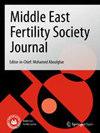The effect of vitamin D on the hormonal profile of women with polycystic ovarian syndrome: a systematic review and meta-analysis
IF 1.3
Q4 REPRODUCTIVE BIOLOGY
引用次数: 0
Abstract
Polycystic ovarian syndrome (PCOS) is recognized as the most common endocrine disorder among women of reproductive age and the most common cause of infertility. Given the importance of the subject and the inconsistency of the results of the primary studies, the present study aimed at estimating the pooled effect of vitamin D on the hormonal profile of women with PCOS using systematic review and meta-analysis. A systematic literature review was performed in PubMed, Scopus, Embase, Web of Science (WoS), Cochrane, ClinicalTrials.gov databases, and Google Scholar motor engine using related Medical Subject Headings (MeSH) and Free Text words with no time limit to April 2022. Heterogeneity among studies was quantified using I2 index. After eliminating duplicates and irrelevant studies, ultimately, 19 articles with a sample size of 450 in the intervention group and 450 in the control group were included in the meta-analysis. As a result of the combination of studies, mean the standardized difference (SMD) before and after the intervention was obtained 0.241 ± 0.098 for dehydroepiandrosterone sulfate (DHEAS), 0.330 ± 0.092 for sex hormone-binding globulin (SHBG), 0.707 ± 0.171 for testosterone, 0.614 ± 0.199 for luteinizing hormone (LH), 0.220 ± 0.119 for follicle-stimulating hormone (FSH), 0.655 ± 0.505 for anti-Müllerian hormone (AMH), and 0.369 ± 0.109 for Free Androgen Index (FAI) in the intervention group compared to the control group. The results indicated that 8-week interventions had a greater positive effect than 12-week interventions. The results of the current meta-analysis revealed a significant positive effect of vitamin D on the hormonal profile of women with PCOS, which should be considered by obstetricians and midwives.维生素 D 对多囊卵巢综合征妇女荷尔蒙特征的影响:系统综述和荟萃分析
多囊卵巢综合症(PCOS)是育龄妇女最常见的内分泌疾病,也是导致不孕的最常见原因。鉴于该课题的重要性以及主要研究结果的不一致性,本研究旨在通过系统综述和荟萃分析,估算维生素 D 对多囊卵巢综合征女性荷尔蒙特征的总体影响。在 PubMed、Scopus、Embase、Web of Science (WoS)、Cochrane、ClinicalTrials.gov 数据库和谷歌学术(Google Scholar)搜索引擎中使用相关的医学主题词(MeSH)和自由文本词进行了系统性文献综述,时间不限,至 2022 年 4 月。使用 I2 指数量化研究之间的异质性。在剔除重复和不相关的研究后,最终有 19 篇文章被纳入荟萃分析,干预组和对照组的样本量分别为 450 和 450。综合各项研究结果,干预前后的平均标准化差异(SMD)分别为:硫酸脱氢表雄酮(DHEAS)0.241 ± 0.098,性激素结合球蛋白(SHBG)0.330 ± 0.092,睾酮(Testosterone)0.707 ± 0.171,左旋睾酮(LLL)0.与对照组相比,干预组的黄体生成素(LH)为 0.614 ± 0.199,卵泡刺激素(FSH)为 0.220 ± 0.119,抗缪勒氏管激素(AMH)为 0.655 ± 0.505,游离雄激素指数(FAI)为 0.369 ± 0.109。结果表明,8 周干预比 12 周干预的积极效果更大。目前的荟萃分析结果表明,维生素 D 对多囊卵巢综合征妇女的荷尔蒙状况有显著的积极影响,产科医生和助产士应加以考虑。
本文章由计算机程序翻译,如有差异,请以英文原文为准。
求助全文
约1分钟内获得全文
求助全文
来源期刊

Middle East Fertility Society Journal
REPRODUCTIVE BIOLOGY-
CiteScore
2.80
自引率
0.00%
发文量
32
审稿时长
45 weeks
 求助内容:
求助内容: 应助结果提醒方式:
应助结果提醒方式:


